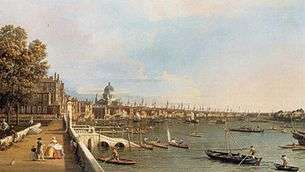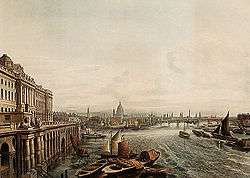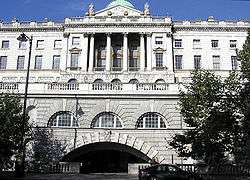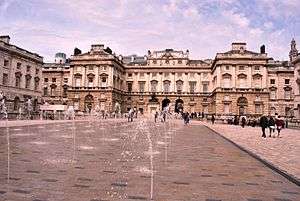Somerset House
| Somerset House | |
|---|---|
|
The courtyard of Somerset House, from the North Wing entrance | |
 Location within central London | |
| General information | |
| Architectural style | Neoclassical |
| Location |
Strand London, WC2 |
| Country | United Kingdom |
| Coordinates | 51°30′39.7″N 0°07′01.9″W / 51.511028°N 0.117194°WCoordinates: 51°30′39.7″N 0°07′01.9″W / 51.511028°N 0.117194°W |
| Current tenants | Multiple |
| Construction started | 1776 |
| Cost | £462,323 (1801)[1] |
| Landlord | Somerset House Trust |
| Design and construction | |
| Architect | Sir William Chambers |
| Designations | Grade I listed building |
| Website | |
|
www | |
Somerset House is a large Neoclassical building situated on the south side of the Strand in central London, overlooking the River Thames, just east of Waterloo Bridge. The building, originally the site of a Tudor palace, was designed by Sir William Chambers in 1776, and further extended with Victorian wings to the east and west in 1831 and 1856 respectively.[2][3] The East Wing forms part of the adjacent Strand campus of King's College London.[4]
History
16th century
In the sixteenth century, the Strand, the north bank of the Thames between the City of London and the Palace of Westminster was a favoured site for the mansions of the nobility. In 1539 Edward Seymour, 1st Earl of Hertford (d.1552), obtained a grant of land at "Chester Place, outside Temple Bar, London" from his brother-in-law King Henry VIII. When his nephew the boy-king Edward VI came to the throne in 1547, Seymour became Duke of Somerset and Lord Protector. In about 1549 he pulled down an old Inn of Chancery and other houses which stood on the site and began to build himself a palatial residence, making liberal use of other nearby buildings including some of the chantry chapels and cloisters at St. Paul's Cathedral which were demolished partly at his behest as part of the ongoing Dissolution of the Monasteries. It was a two storey house built around a quadrangle with a gateway rising to three stories and was one of the earliest examples of Renaissance architecture in England. It is not known who designed the building.
Before it was finished, however, Somerset was overthrown, attainted by Parliament and in 1552 was executed on Tower Hill. "Somerset Place" then came into the possession of the Crown. His royal nephew's half-sister the future Queen Elizabeth I lived there during the reign of her half-sister Queen Mary I (1553–1558). The process of completion and improvement was slow and costly. As late as 1598 Stow refers to it as "yet unfinished".
17th century

In the 17th century, the house was used as a residence by queens consort. During the reign of King James I, the building became the London residence of his wife, Anne of Denmark, and was renamed Denmark House. She commissioned a number of expensive additions and improvements, some to designs by Inigo Jones. In particular, during the period between 1630 and 1635 he built a Chapel where Henrietta Maria of France, wife of King Charles I, could exercise her Roman Catholic religion. This was in the care of the Capuchin Order and was on a site to the south-west of the Great Court. A small cemetery was attached and some of the tombstones are still to be seen built into one of the walls of a passage under the present quadrangle.
Royal occupation of Somerset House was interrupted by the English Civil War and in 1649 Parliament tried to sell it. They failed to find a buyer, though a sale of the contents realised the very considerable sum (for that time) of £118,000. Use was still found for it however. Part of it served as an Army headquarters, General Fairfax (the Parliamentary Commander-in-Chief) being given official quarters there; lodgings were also provided for certain other Parliamentary notables. It was in Somerset House that Oliver Cromwell's body lay in state after his death in 1658.
Two years later, with the Restoration, Queen Henrietta Maria returned and in 1661 began a considerable programme of rebuilding, the main feature of which was a magnificent new river front, again to the design of the late Inigo Jones, who had died at Somerset House in 1652. However she returned to France in 1665 before it was finished. It was then used as an occasional residence by Catherine of Braganza, wife of King Charles II. During her time it received a certain notoriety as being, in the popular mind, a hot-bed of Catholic conspiracy. Titus Oates made full use of this prejudice in the fabricated details of the Popish Plot and it was alleged that Sir Edmund Berry Godfrey, whose murder was one of the great mysteries of the age, had been killed in Somerset House before his body had been smuggled out and thrown into a ditch below Primrose Hill.
Somerset House was refurbished by Sir Christopher Wren in 1685. After the Glorious Revolution in 1688, Somerset House entered on a long period of decline, being used (after Queen Catherine left England in 1692) for grace and favour residences. In the conditions of the time this meant almost inevitably that little money could be found for its upkeep, and a slow process of decay crept in. During the 18th century, however, the building ceased its royal associations. Though the view from its terraced riverfront garden, open to the public, was painted twice on his London visit by Canaletto (looking upriver and down), it was used for storage, as a residence for visiting overseas dignitaries and as a barracks for troops. Suffering from neglect, Old Somerset House began to be demolished in 1775.
Sir William Chambers' Somerset House, 1776
Since the middle of the 18th century there had been growing criticism that London had no great public buildings. Government departments and the learned societies were huddled away in small old buildings all over the city. Developing national pride found comparison with the capitals of the Continent disquieting. Edmund Burke was the leading proponent of the scheme for a "national building", and in 1775 Parliament passed an Act for the purpose of, inter alia, "erecting and establishing Publick Offices in Somerset House, and for embanking Parts of the River Thames lying within the bounds of the Manor of Savoy". The list of "Publick Offices" mentioned in the Act comprised "The Salt Office, The Stamp Office, The Tax Office, The Navy Office, The Navy Victualling Office, The Publick Lottery Office, The Hawkers and Pedlar Office, The Hackney Coach Office, The Surveyor General of the Crown Lands Office, The Auditors of the Imprest Office, The Pipe Office, The Office of the Duchy of Lancaster, The Office of the Duchy of Cornwall, The Office of Ordnance, The King's Bargemaster's House, The King's Bargehouses".
Sir William Chambers, Surveyor-General of Works was appointed at a salary of £2,000 p.a. to design and build the new Somerset House. He spent the last two decades of his life, beginning in 1775, in several phases of building at the present Somerset House. Thomas Telford, then a stonemason, but later an eminent civil engineer, was among those who worked on its construction. One of Chambers's most famous pupils, Thomas Hardwick Jr, helped build parts of the building during his period of training and later wrote a short biography of Chambers. By 1780 the North Wing, fronting the Strand, was complete. Its design was based on Inigo Jones's drawings for the riverfront of the former building.
It is not certain at what pace the rest of the construction progressed, but it is clear that the outbreak of war with France caused delays through lack of money. Chambers died in 1796; most of the building was completed after Chambers' death by James Wyatt. However we know that building work was still going on in 1801; and there are indications that as late as 1819 some decorative work still needed to be completed. This original building (which did not yet include the "New Wing" and King's College London, situated behind the West and East Wings of the quadrangle respectively) probably cost about £500,000.
At that time of construction, the river was not embanked and the Thames lapped the South Wing where three great arches allowed boats and barges to penetrate to landing places within the building.
 The Strand façade of Chambers' Somerset House and the church of St Mary-le-Strand, shown in a view of 1836
The Strand façade of Chambers' Somerset House and the church of St Mary-le-Strand, shown in a view of 1836 The Strand façade today
The Strand façade today Somerset House in 1817, showing how the Thames originally flowed directly past the building.
Somerset House in 1817, showing how the Thames originally flowed directly past the building. The river front of Somerset House today, seen from the Victoria Embankment
The river front of Somerset House today, seen from the Victoria Embankment
19th century
Magnificent as the new building was, it was something short of what Chambers had intended, for he had planned for additional wings to the east and west of the quadrangle. Cost had been the inhibiting factor. Eventually King's College London was erected to the east (the Government granting the land on condition that the design conformed to Chambers' original design) by subscription between 1829 and 1834. Then, increasing demand for space led to another and last step. The western edge of the site was occupied by a row of houses used as dwellings for Admiralty officials who worked in the South Wing. Between 1851 and 1856 these were demolished and a further wing erected. 150 years later this part of the building is still known as the "New Wing". Somerset House now presents more of the aspect of a terrace than Chambers would have intended.
The building housed various learned societies, including the Royal Academy, which Chambers was instrumental in founding, and the Royal Society and Society of Antiquaries (the RA had been among the last tenants of the previous building). The University of London also had accommodation there and the learned Societies retained a presence in the building until the 1870s.
20th century to present

Somerset House had its share of trials and tribulations during World War II. Apart from comparatively minor blast effects at various times, sixteen rooms and the handsome rotunda staircase (the Nelson Stair) were completely destroyed in the South Wing, and a further 27 damaged in the West Wing by a direct hit in October 1940. Still more windows were shattered and balustrades toppled, but the worst was over by the end of May 1941.
It was not until the 1950s that this damage to the South Wing was repaired. The work required skilled masons, whose services were hard to come by in the early post-war years. Sir Albert Richardson was appointed architect for the reconstruction. He skillfully recreated the Nelson Room and rebuilt the Nelson Stair. The work was completed in 1952 at a cost of (then) £84,000. The newly restored part of the South Wing was taken by the Inland Revenue's Solicitor's Office and "Establishments" (now commonly "HR") Division, augmenting their existing accommodation in the West Wing.
Government use
The main government department in the early days was the Admiralty, leading to the legend that Nelson worked in the building for a time. It is almost certain there is no foundation for this story, although his elder brother Maurice was employed there. There is still a conference room known as the "Nelson Room", a graceful apartment which has a copy of the Probate of Nelson's will framed on the wall.
Other departments in Somerset House during the first half of the 19th century were the Poor Law Commissioners and the Tithe Commissioners; in 1837 the Registrar General of Births, Marriages and Deaths set up his office in the North Wing, establishing a connection that lasted for almost 150 years. This office held all Birth, Marriage and Death certificates in England and Wales; indexes to these are now at The National Archives. From its foundation in 1837 the Government School of Design, which was much later to become the Royal College of Art, was housed in the complex, until in 1853 the Registry needed to expand its space.
Somerset House Laboratory, the laboratory originally established in 1842 for the prevention of the adulteration of tobacco products, started as basically a one-man operation by George Phillips. The laboratory was run by Inland Revenue and enhanced by the Sale of Food and Drugs Act 1875. Phillips retired as principal chemist in 1874. Dr. James Bell was then the principal chemist of Somerset House Laboratory until his retirement in 1894.[5] He was replaced as principal chemist by Sir Thomas Edward Thorpe, who in 1897 closed the laboratory within Somerset House and transferred the activities of the Government Laboratory to a new building of his own design.
From the beginning of the new Somerset House there was a fiscal presence in the shape of the Stamp Office and the Tax Office. These two Offices proved more tenacious than the others, going on to help form what became the Inland Revenue. This department became the largest occupier of the building, although the North Wing became available for public purposes in the 1970s.
Somerset House continued in use by the Inland Revenue after it was created by a merger of the Stamp and Taxes Offices and the Excise Department in 1849. The Inland Revenue was eventually merged in 2005 with HM Customs and Excise and its successor HM Revenue & Customs continued to occupy the building, although its executive and senior management moved to 100 Parliament St. shortly after the merger. Various divisions and directorates of HMRC previously occupied the East, West and New Wings of Somerset House until early 2009 when almost all staff relocated with most moving across the street to Bush House. In 2004 it was proposed that the newly proposed Supreme Court of the United Kingdom be housed in the New Wing because of its proximity to the legal quarter nearby, the Royal Courts of Justice and Inns of Court; however, a decision was made to use Middlesex Guildhall instead.
The West Wing of the House is home to the Representative of Anguilla, the diplomatic mission of the British Overseas Territory of Anguilla.[6]
A home for arts and learning


As well as the Royal Academy, and the Government Art School, Somerset House was fitted out to house the Royal Society and the Society of Antiquaries. These, and the Geological Society, moved to Burlington House in Piccadilly in the early 19th century.
In the late 20th century the building was reinvigorated as a centre for the visual arts. The first institution to move in was the Courtauld Institute of Art, including the Courtauld Gallery, which has an important collection of old master and impressionist paintings. In the late 1990s the main courtyard ceased to be a civil service carpark, and the main terrace overlooking the Thames was refurbished and opened to the public, these alterations being overseen by the leading conservation architects Donald Insall & Associates. A visitor centre featuring audiovisual displays on the history of the building; the gilded state barge of the Lord Mayor of the City of London; and a shop and café were opened in the wing overlooking the river. The Gilbert Collection of decorative arts, and the Hermitage Rooms, which stage exhibitions of items loaned from the Hermitage Museum in St Petersburg, moved into the same area.[7] The last Hermitage exhibition took place in 2007 and the Gilbert Collection galleries closed in 2008; the collection moved into new galleries at the Victoria and Albert Museum in June 2009. Somerset House now puts on a programme of art exhibitions drawing on various sources.[8]
In the winter the central courtyard is home to a popular open air ice rink, as seen during the opening credits of the 2003 Christmas-themed film Love Actually.[9] At other times, an array of fountains display 55 vertical jets of water rising to random heights.[10] The courtyard is also used as a concert venue.[11] A series of music events called the 'Summer series' are held in July each year. These have included performances from artists such as Bat For Lashes, Lupe Fiasco, Snow Patrol, We Are Scientists, Lily Allen and Amy Winehouse. A Goldfrapp concert was filmed in the courtyard and released on the Wonderful Electric DVD. There is also an annual summer season of outdoor film showings.
The East wing is occupied by King's College London's Cultural Institute, Executive Centre and the Dickson Poon School of Law.
Filming location
Somerset House is a popular filming location with its exterior featuring in several big budget Hollywood films. Among these include two James Bond films, Tomorrow Never Dies and GoldenEye,[12][13] and several scenes of the 2003 film, Shanghai Knights starring Jackie Chan and Owen Wilson were filmed in the courtyard of Somerset House.[14][15] Elements of the 2008 film The Duchess starring Keira Knightley and Ralph Fiennes were filmed in October 2007.[16] Somerset House was also used as a filming location in several Sherlock Holmes films, including the 1970 film The Private Life of Sherlock Holmes, and more recently, Sherlock Holmes (2009) starring Jude Law and Robert Downey, Jr. directed by Guy Ritchie.[17][18] Exterior shots of Somerset House were also used in the 1999 Tim Burton horror film, Sleepy Hollow starring Johnny Depp and the 2006 film, Flyboys.[19][20] It was used as a filming location in the 2012 Bollywood film Jab Tak Hai Jaan, starring Shah Rukh Khan, Katrina Kaif and Anushka Sharma, and directed by Yash Chopra.[21] Somerset House Courtyard was also used in the 2008 movie Last Chance Harvey with Dustin Hoffman and Emma Thompson. Emma’s character says she likes to sit and watch the children play under the fountains. Scenes were filmed in Somerset House in the Olympus Has Fallen sequel, London Has Fallen.[22]
Somerset House was also the main location for the BBC's New Year Live television show, presented by Natasha Kaplinsky, which celebrated the arrival of the year 2006.[23] It also stood in for Buckingham Palace in the episode "Celebrity" of Spooks.
Snow Patrol recorded a DVD at Somerset House as part of their Final Straw tour. It was filmed on 8 August 2004 and was released in November 2004.
Influence of Chambers' design
Charles Bulfinch's Massachusetts State House, begun in 1795, is a work "frankly derivative" of Somerset House.[24]
References
Notes
- ↑ "Since the 18th century". Somerset House Trust. Retrieved 27 February 2013.
- ↑ Humphreys (2003), pp. 165-6
- ↑ Somerset House Trust (2010), Annual Report (PDF), Somerset House Trust, p. 3, retrieved 27 February 2013
- ↑ "Restoration of a Grade I listed Building" (PDF). WRAP. Retrieved 27 February 2013.
- ↑ "obit. Dr. James Bell, C.B., F.R.S.". Nature. 77 (2006): 539–540. 9 April 1908. doi:10.1038/077539a0.
- ↑ "The London Diplomatic List" (PDF). 14 December 2013.
- ↑ "Hermitage Rooms at Somerset House". Cultural Innovations. 2009. Retrieved 27 February 2013.
- ↑ "Somerset House". Time Out London. Retrieved 27 February 2013.
- ↑ "The Big Skate: outdoor ice rinks in London". BBC. 25 November 2009. Retrieved 27 February 2013.
- ↑ Humphreys (2003), p. 166
- ↑ Somerset House - Music
- ↑ "Tomorrow Never Dies (1997)". British-Film-Locations.com. Retrieved 28 February 2013.
- ↑ "Goldeneye (1995)". British-Film-Locations.com. Retrieved 28 February 2013.
- ↑ "Shanghai Knights (2003)". British-Film-Locations.com. Retrieved 28 February 2013.
- ↑ "Shanghai Knights (2003)". British-Film-Locations.com. Retrieved 28 February 2013.
- ↑ "Duchess, The (2008)". British-Film-Locations.com. Retrieved 28 February 2013.
- ↑ "Private Life Of Sherlock Holmes, The (1970)". British-Film-Locations.com. Retrieved 28 February 2013.
- ↑ "Sherlock Holmes (2009)". British-Film-Locations.com. Retrieved 28 February 2013.
- ↑ "Sleepy Hollow (1999)". British-Film-Locations.com. Retrieved 28 February 2013.
- ↑ "Flyboys (2006)". British-Film-Locations.com. Retrieved 28 February 2013.
- ↑ Steven Baker (23 September 2012). "'Jab Tak Hai Jaan' London film locations revealed". Digital Spy. Retrieved 28 February 2013.
- ↑ "Gerard Butler spotted speeding down Strand in filming of action thriller". 8 March 2015. Retrieved 31 March 2015.
- ↑ "Somerset House, The Portico Room". Pole Structural Engineers. Retrieved 28 February 2013.
- ↑ Shand-Tucci, Douglass. Built in Boston: City and Suburb, 1800-2000, p. 6. University of Massachusetts Press, Amherst, 1999. ISBN 1-55849-201-1.
Bibliography
- Humphreys, Rob (2003). The Rough Guide to London (5 ed.). Rough Guides Ltd. pp. 165–6. ISBN 1843530937.
- Borer, Mary Cathcart The City of London: A History. New York: McKay, 1977 (pp 156)
- Stow, John A Survey of London. Reprinted from the Text of 1603. Ed. Charles Lethbridge Kingsford. 2 vols. Oxford: Clarendon, 1908 (2:394-5
External links
 Media related to Somerset House at Wikimedia Commons
Media related to Somerset House at Wikimedia Commons- Official website of Somerset House



.svg.png)